Combining Demand for Ecosystem Services with Ecosystem Conditions of Vacant Lots to Support Land Preservation and Restoration Decisions
Abstract
1. Introduction
- How can ecosystem conditions assessment, combined with ES demand, help to identify priority vacant lots for restoration and preservation decisions in urban settings?
2. Case Study: The Intermunicipal Area of Northern Milan
3. Materials and Methods
3.1. Identification of Vacant Lots and Selection of Ecosystem Services
3.2. Assessment of Ecosystem Services Demand
- (a)
- Air purification
- (b)
- Runoff mitigation
- (c)
- Microclimate regulation
- (d)
- Pollination
3.3. Assessment of Ecosystem Conditions of Vacant Lots
3.3.1. Indicators Selection and Reference Level Definition
3.3.2. Building Ecosystem Condition Indices
3.4. Combining Demand and Condition
- (1)
- Low preservation priority: Lots where none of the condition indices values exceed the reference level are included in this class, indicating a very low ecosystem condition.
- (2)
- Medium-low preservation priority: This class includes lots where only one of the four condition indices values exceeds the reference level.
- (3)
- Medium preservation priority: This class comprises lots where two out of four of the condition indices values exceed the reference level.
- (4)
- Medium-high preservation priority: This class comprises lots where three out of four of the condition indices values exceed the reference level.
- (5)
- High preservation priority: This class includes lots where all four indices values exceed the defined reference level, indicating a high ecosystem condition.
4. Results
5. Discussion and Conclusions
Supplementary Materials
Author Contributions
Funding
Institutional Review Board Statement
Informed Consent Statement
Data Availability Statement
Conflicts of Interest
Abbreviations
| ES | Ecosystem Services |
| EC | Ecosystem Conditions |
| GI | Green Infrastructure |
| NbS | Nature-based Solutions |
References
- Kjærås, K. The politics of urban densification in Oslo. Urban Stud. 2023, 61, 40–57. [Google Scholar] [CrossRef]
- Blanc, F.; Scanlon, K.; White, T. Living in a Denser London. How Residents See Their Homes; LSE London: London, UK, 2020. [Google Scholar]
- Livingstone, N.; Fiorentino, S.; Short, M. Planning for residential ‘value’? London’s densification policies and impacts. Build. Cities 2021, 2, 203–219. [Google Scholar] [CrossRef]
- Dembski, S. ‘Organic’ approaches to planning as densification strategy? The challenge of legal contextualisation in Buiksloterham, Amsterdam. Town Plan. Rev. 2020, 91, 283–303. [Google Scholar] [CrossRef]
- Herdt, T.; Jonkman, A.R. The acceptance of density: Conflicts of public and private interests in public debate on urban densification. Cities 2023, 140, 104451. [Google Scholar] [CrossRef]
- Balikçi, S.; Giezen, M.; Arundel, R. The paradox of planning the compact and green city: Analyzing land-use change in Amsterdam and Brussels. J. Environ. Plan. Manag. 2022, 65, 2387–2411. [Google Scholar] [CrossRef]
- Cortinovis, C.; Geneletti, D.; Haase, D. Higher immigration and lower land take rates are driving a new densification wave in European cities. NPJ Urban Sustain. 2022, 2, 19. [Google Scholar] [CrossRef]
- Khoshkar, S.; Balfors, B.; Wärnbäck, A. Planning for green qualities in the densification of suburban Stockholm—Opportunities and challenges. J. Environ. Plan. Manag. 2018, 61, 2613–2635. [Google Scholar] [CrossRef]
- Verheij, J.; Ay, D.; Gerber, J.-D.; Nahrath, S. Ensuring Public Access to Green Spaces in Urban Densification: The Role of Planning and Property Rights. Plan. Theory Pract. 2023, 24, 342–365. [Google Scholar] [CrossRef]
- Di Pietro, F.; Robert, A. Cities and Nature Urban Wastelands A form of Urban Nature? Available online: http://www.springer.com/series/10068 (accessed on 12 December 2023).
- Nefs, M. Unused urban space: Conservation or transformation? Polemics about the future of urban wastelands and abandoned building. City Time 2006, 2, 47–58. [Google Scholar]
- La Rosa, D.; Privitera, R. Characterization of non-urbanized areas for land-use planning of agricultural and green infrastructure in urban contexts. Landsc. Urban Plan. 2013, 109, 94–106. [Google Scholar] [CrossRef]
- Kim, G.; Miller, P.A.; Nowak, D.J. Assessing urban vacant land ecosystem services: Urban vacant land as green infrastructure in the City of Roanoke, Virginia. Urban For. Urban Green. 2015, 14, 519–526. [Google Scholar] [CrossRef]
- McPhearson, T.; Kremer, P.; Hamstead, Z.A. Mapping ecosystem services in New York City: Applying a social-ecological approach in urban vacant land. Ecosyst. Serv. 2013, 5, 11–26. [Google Scholar] [CrossRef]
- Smith, J.P.; Li, X.; Turner, B.L. Lots for greening: Identification of metropolitan vacant land and its potential use for cooling and agriculture in Phoenix, AZ, USA. Appl. Geogr. 2017, 85, 139–151. [Google Scholar] [CrossRef]
- Pham, M.A.; Spring, M.R.; Sivakoff, F.S.; Gardiner, M.M. Reclaiming urban vacant land to manage stormwater and support insect habitat. Urban Ecosyst. 2023, 26, 1813–1827. [Google Scholar] [CrossRef]
- London Biodiversity Partnership Urban Wastelands Habitat Statement. Available online: https://www.lbp.org.uk/02audit_pages/aus20_urban.html (accessed on 21 November 2023).
- Luo, S.; Havik, K. Gardens of interstitial wildness cultivating indeterminacy in the metropolitan landscape. Spool 2020, 7, 9–22. [Google Scholar] [CrossRef]
- Ossola, A.; Locke, D.; Lin, B.; Minor, E. Yards increase forest connectivity in urban landscapes. Landsc. Ecol. 2019, 34, 2935–2948. [Google Scholar] [CrossRef]
- Threlfall, C.G.; Law, B.; Banks, P.B. Sensitivity of insectivorous bats to urbanization: Implications for suburban conservation planning. Biol. Conserv. 2012, 146, 41–52. [Google Scholar] [CrossRef]
- European Commission. Our Life Insurance, Our Natural Capital: An EU Biodiversity Strategy to 2020. 2011. Available online: https://www.eea.europa.eu/policy-documents/our-life-insurance-our-natural (accessed on 14 November 2023).
- Escobedo, F.J.; Giannico, V.; Jim, C.Y.; Sanesi, G.; Lafortezza, R. Urban forests, ecosystem services, green infrastructure and nature-based solutions: Nexus or evolving metaphors? Urban For. Urban Green. 2019, 37, 3–12. [Google Scholar] [CrossRef]
- Fang, X.; Li, J.; Ma, Q. Integrating green infrastructure, ecosystem services and nature-based solutions for urban sustainability: A comprehensive literature review. Sustain. Cities Soc. 2023, 98, 104843. [Google Scholar] [CrossRef]
- Hansen, R.; Pauleit, S. From Multifunctionality to Multiple Ecosystem Services? A Conceptual Framework for Multifunctionality in Green Infrastructure Planning for Urban Areas. AMBIO 2014, 43, 516–529. [Google Scholar] [CrossRef]
- Ronchi, S.; Arcidiacono, A.; Pogliani, L. Integrating green infrastructure into spatial planning regulations to improve the performance of urban ecosystems. Insights from an Italian case study. Sustain. Cities Soc. 2020, 53, 101907. [Google Scholar] [CrossRef]
- Longato, D.; Cortinovis, C.; Albert, C.; Geneletti, D. Practical applications of ecosystem services in spatial planning: Lessons learned from a systematic literature review. Environ. Sci. Policy 2021, 119, 72–84. [Google Scholar] [CrossRef]
- Ronchi, S. Ecosystem Services for Planning: A Generic Recommendation or a Real Framework? Insights from a Literature Review. Sustainability 2021, 13, 6595. [Google Scholar] [CrossRef]
- Cortinovis, C.; Geneletti, D. A performance-based planning approach integrating supply and demand of urban ecosystem services. Landsc. Urban Plan. 2020, 201, 103842. [Google Scholar] [CrossRef]
- Pappalardo, V.; La Rosa, D. Policies for sustainable drainage systems in urban contexts within performance-based planning approaches. Sustain. Cities Soc. 2020, 52, 101830. [Google Scholar] [CrossRef]
- Roche, P.K.; Campagne, C.S. From ecosystem integrity to ecosystem condition: A continuity of concepts supporting different aspects of ecosystem sustainability. Curr. Opin. Environ. Sustain. 2017, 29, 63–68. [Google Scholar] [CrossRef]
- United Nations. System of Environmental-Economic Accounting-Ecosystem Accounting (SEEA EA). 2021. Available online: https://seea.un.org/ecosystem-accounting (accessed on 15 December 2023).
- Keith, H.; Czúcz, B.; Jackson, B.; Driver, A.; Nicholson, E.; Maes, J. A conceptual framework and practical structure for implementing ecosystem condition accounts. One Ecosyst. 2020, 5, e58216. [Google Scholar] [CrossRef]
- European Commission. EU Biodiversity Strategy for 2030—Bringing Nature Back into Our Lives. 2021. Available online: https://data.europa.eu/doi/10.2779/677548 (accessed on 15 July 2023).
- Bruzón, A.G.; Arrogante-Funes, P.; Santos-Martín, F. Modelling and testing forest ecosystems condition account. J. Environ. Manag. 2023, 345, 118676. [Google Scholar] [CrossRef]
- Chen, Y.; Vardon, M.; Keith, H.; Van Dijk, A.; Doran, B. Linking ecosystem accounting to environmental planning and management: Opportunities and barriers using a case study from the Australian Capital Territory. Environ. Sci. Policy 2023, 142, 206–219. [Google Scholar] [CrossRef]
- Farrell, C.A.; Coleman, L.; Kelly-Quinn, M.; Obst, C.G.; Eigenraam, M.; Norton, D.; O’donoghue, C.; Kinsella, S.; Delargy, O.; Stout, J.C. Applying the system of environmental economic accounting-ecosystem accounting (Seea-ea) framework at catchment scale to develop ecosystem extent and condition accounts. One Ecosyst. 2021, 6, e65582. [Google Scholar] [CrossRef]
- Framstad, E.; Kolstad, A.L.; Nybø, S.; Töpper, J.; Vandvik, V. The Condition of Forest and Mountain Ecosystems in Norway. Assessment by the IBECA Method. NINA Report 2100; Norwegian Institute for Nature Research: Trondheim, Noorwegen, 2022. [Google Scholar]
- Kim, M.; Koo, N.; Kim, A.R.; Lee, K.; Yun, S.J. Reference Ecosystem Condition-Based Syntaxonomic Study for Ecological Restoration and Protection of Temperate Forests in South Korea. Diversity 2025, 17, 40. [Google Scholar] [CrossRef]
- McVittie, A.; Cole, L.; Wreford, A.; Sgobbi, A.; Yordi, B. Ecosystem-based solutions for disaster risk reduction: Lessons from European applications of ecosystem-based adaptation measures. Int. J. Disaster Risk Reduct. 2018, 32, 42–54. [Google Scholar] [CrossRef]
- Grassi, G.; Cescatti, A.; Matthews, R.; Duveiller, G.; Camia, A.; Federici, S.; House, J.; De Noblet-Ducoudré, N.; Pilli, R.; Vizzarri, M. On the realistic contribution of European forests to reach climate objectives. Carbon Balance Manag. 2019, 14, 8. [Google Scholar] [CrossRef]
- Cook-Patton, S.C.; Drever, C.R.; Griscom, B.W.; Hamrick, K.; Hardman, H.; Kroeger, T.; Pacheco, P.; Raghav, S.; Stevenson, M.; Webb, C.; et al. Protect, manage and then restore lands for climate mitigation. Nat. Clim. Chang. 2021, 11, 1027–1034. [Google Scholar] [CrossRef]
- Liu, O.Y.; Russo, A. Assessing the contribution of urban green spaces in green infrastructure strategy planning for urban ecosystem conditions and services. Sustain. Cities Soc. 2021, 68, 102772. [Google Scholar] [CrossRef]
- Nowell, M.; Barton, D.N.; Aslaksen, I.; Garnåsjordet, A.; Steinnes, M.; Cimburova, Z. Per Arild Garnåsjordet, Margrete Steinnes, Zofie Cimburova, Urban Green. Urban Green. Integrating Ecosystem Extent and Condition as a Basis for Ecosystem Accounts. Examples from the Oslo Region. 2020. Available online: http://www.ssb.no/en/forskning/discussion-papers (accessed on 13 December 2023).
- Hanssen, F.; Barton, D.N.; Venter, Z.S.; Nowell, M.S.; Cimburova, Z. Utilizing LiDAR data to map tree canopy for urban ecosystem extent and condition accounts in Oslo. Ecol. Indic. 2021, 130, 108007. [Google Scholar] [CrossRef]
- Nedkov, S.; Zhiyanski, M.; Dimitrov, S.; Borisova, B.; Popov, A.; Ihtimanski, I.; Yaneva, R.; Nikolov, P.; Bratanova-Doncheva, S. Mapping and assessment of urban ecosystem condition and services using integrated index of spatial structure. One Ecosyst. 2017, 2, e14499. [Google Scholar] [CrossRef]
- Hou, Y.; Liu, Y.; Zeng, H. Assessment of urban ecosystem condition and ecosystem services in Shenzhen based on the MAES analysis framework. Ecol. Indic. 2023, 155, 110962. [Google Scholar] [CrossRef]
- Kourdounouli, C.; Jönsson, A.M. Urban ecosystem conditions and ecosystem services—A comparison between large urban zones and city cores in the EU. J. Environ. Plan. Manag. 2020, 63, 798–817. [Google Scholar] [CrossRef]
- Wang, Y.; Zhu, L.; Yang, X.; Zhang, X.; Wang, X.; Pei, J.; Zhou, L.; Luo, Z.; Fang, Q.; Liang, M.; et al. Evaluating the conservation priority of key biodiversity areas based on ecosystem conditions and anthropogenic threats in rapidly urbanizing areas. Ecol. Indic. 2022, 142, 109245. [Google Scholar] [CrossRef]
- Salata, S.; Ronchi, S.; Giaimo, C.; Arcidiacono, A.; Pantaloni, G.G. Performance-Based Planning to Reduce Flooding Vulnerability Insights from the Case of Turin (North-West Italy). Sustainability 2021, 13, 5697. [Google Scholar] [CrossRef]
- Córdoba Hernández, R.; Camerin, F. The application of ecosystem assessments in land use planning: A case study for supporting decisions toward ecosystem protection. Futures 2024, 161, 103399. [Google Scholar] [CrossRef]
- Villamagna, A.M.; Angermeier, P.L.; Bennett, E.M. Capacity, pressure, demand, and flow: A conceptual framework for analyzing ecosystem service provision and delivery. Ecol. Complex. 2013, 15, 114–121. [Google Scholar] [CrossRef]
- Munafò, M. (Ed.) Consumo di Suolo, Dinamiche Territoriali e Servizi Ecosistemici. Edizione 2023. Report SNPA 37/23; Sistema Nazionale per la protezione dell’Ambiente: Roma, Italy, 2023. [Google Scholar]
- Confindustria Lombardia. Piano Strategico #Lombardia2030; Confindustria Lombardia: Milan, Italy, 2015. [Google Scholar]
- Regione Lombardia. Progetto di Integrazione del PTR ai Sensi Della l.r.31/14. Criteri per l’attuazione Della Politica di Riduzione del Consumo di Suolo. Aggiornamento 2021. Available online: https://www.regione.lombardia.it/wps/wcm/connect/cfa792b3-cc7e-42ac-8595-1a9b6b1e0cb8/criteri-attuazione-aggiornamento-2021-integrazione-ptr-consumo-suolo.pdf?MOD=AJPERES&CACHEID=ROOTWORKSPACE-cfa792b3-cc7e-42ac-8595-1a9b6b1e0cb8-nYcm0Fh (accessed on 13 May 2025).
- Eurostat Population and Housing Census 2021: First EU Results. Available online: https://ec.europa.eu/eurostat/web/products-eurostat-news/w/DDN-20230330-2 (accessed on 14 July 2023).
- Metropolitan Landscapes: Towards a Shared Construction of the Resilient City of the Future; Contin, A., Ed.; Landscape Series; Springer International Publishing: Cham, Switzerland, 2021; Volume 28, ISBN 978-3-030-74423-6. [Google Scholar]
- Marull, J.; Farré, M.; Galletto, V.; Trullén, J. Analysing sustainable-progress typologies in European metropolitan regions. Cities 2023, 137, 104347. [Google Scholar] [CrossRef]
- Nabielek, K.; Hamers, D.; Evers, D. Cities in Europe; Netherlands Environmental Assessment Agency: The Hauge, The Netherlands, 2016. [Google Scholar]
- Regione Lombardia. Geoportale Regione Lombardia. Available online: https://www.geoportale.regione.lombardia.it/ (accessed on 14 January 2024).
- La Notte, A.; Liquete, C.; Grizzetti, B.; Maes, J.; Egoh, B.N.; Paracchini, M.L. An ecological-economic approach to the valuation of ecosystem services to support biodiversity policy. A case study for nitrogen retention by Mediterranean rivers and lakes. Ecol. Indic. 2015, 48, 292–302. [Google Scholar] [CrossRef]
- Vári, Á.; Kozma, Z.; Pataki, B.; Jolánkai, Z.; Kardos, M.; Decsi, B.; Pinke, Z.; Jolánkai, G.; Pásztor, L.; Condé, S.; et al. Disentangling the ecosystem service ‘flood regulation’: Mechanisms and relevant ecosystem condition characteristics. Ambio 2022, 51, 1855–1870. [Google Scholar] [CrossRef]
- Città Metropolitana di Milano. Piano Strategico Triennale del Territorio Metropolitano, Orizzonte 2026. Available online: https://www.cittametropolitana.mi.it/export/sites/default/Piano_Strategico_2022_2024/doc/01_Rev28_PSTTM_ORIZZONTE-2026_Approvato_13giu23.pdf (accessed on 20 January 2024).
- Salata, S.; Ronchi, S.; Arcidiacono, A. Mapping air filtering in urban areas. A Land Use Regression model for Ecosystem Services assessment in planning. Ecosyst. Serv. 2017, 28, 341–350. [Google Scholar] [CrossRef]
- Fernandes, J.; Antunes, P.; Santos, R.; Zulian, G.; Clemente, P.; Ferraz, D. Coupling spatial pollination supply models with local demand mapping to support collaborative management of ecosystem services. Ecosyst. People 2020, 16, 212–229. [Google Scholar] [CrossRef]
- Wolff, S.; Schulp, C.J.E.; Verburg, P.H. Mapping ecosystem services demand: A review of current research and future perspectives. Ecol. Indic. 2015, 55, 159–171. [Google Scholar] [CrossRef]
- Guillevic, P.G.F.; Nickeson, J.; Hulley, G.; Ghent, D.; Yu, Y.; Trigo, I.; Hook, S.; Sobrino, J.; Remedios, J. Land Surface Temperature Product Validation Best Practice Protocol. Version 1.1. In Good Practices for Satellite-Derived Land Product Validation; Guillevic, P., Göttsche, F., Nickeson, J., Román, M., Eds.; Land Product Validation Subgroup (WGCV/CEOS), 2018. Available online: https://lpvs.gsfc.nasa.gov/PDF/CEOS_LST_PROTOCOL_Feb2018_v1.1.0_light.pdf (accessed on 13 May 2025).
- Sheng, L.; Tang, X.; You, H.; Gu, Q.; Hu, H. Comparison of the urban heat island intensity quantified by using air temperature and Landsat land surface temperature in Hangzhou, China. Ecol. Indic. 2017, 72, 738–746. [Google Scholar] [CrossRef]
- Kabisch, N.; van den Bosch, M.; Lafortezza, R. The health benefits of nature-based solutions to urbanization challenges for children and the elderly—A systematic review. Environ. Res. 2017, 159, 362–373. [Google Scholar] [CrossRef] [PubMed]
- Zulian, G.; Maes, J.; Paracchini, M. Linking Land Cover Data and Crop Yields for Mapping and Assessment of Pollination Services in Europe. Land 2013, 2, 472–492. [Google Scholar] [CrossRef]
- Klein, A.-M.; Vaissière, B.E.; Cane, J.H.; Steffan-Dewenter, I.; Cunningham, S.A.; Kremen, C.; Tscharntke, T. Importance of pollinators in changing landscapes for world crops. Proc. R. Soc. B Biol. Sci. 2007, 274, 303–313. [Google Scholar] [CrossRef]
- Zhao, C.; Sander, H.A.; Hendrix, S.D. Wild bees and urban agriculture: Assessing pollinator supply and demand across urban landscapes. Urban Ecosyst. 2019, 22, 455–470. [Google Scholar] [CrossRef]
- Czúcz, B.; Keith, H.; Driver, A.; Jackson, B.; Nicholson, E.; Maes, J. A common typology for ecosystem characteristics and ecosystem condition variables. One Ecosyst. 2021, 6, e58218. [Google Scholar] [CrossRef]
- Estrada, E.; Bodin, Ö. Using network centrality measures to manage landscape connectivity. Ecol. Appl. 2008, 18, 1810–1825. [Google Scholar] [CrossRef]
- Nardo, M.; Saisana, M.; Saltelli, A.; Tarantola, S. Tools for Composite Indicators Building. 2005. Available online: https://publications.jrc.ec.europa.eu/repository/handle/JRC31473 (accessed on 12 October 2023).
- Cutter, S.L.; Burton, C.G.; Emrich, C.T. Disaster Resilience Indicators for Benchmarking Baseline Conditions. J. Homel. Secur. Emerg. Manag. 2010, 7, 1–23. [Google Scholar] [CrossRef]
- Gathmann, A.; Tscharntke, T. Foraging ranges of solitary bees. J. Anim. Ecol. 2002, 71, 757–764. [Google Scholar] [CrossRef]
- Dargas, J.H.F.; Chaves, S.R.; Fischer, E. Pollination of lark daisy on roadsides declines as traffic speed increases along an Amazonian highway. Plant Biol. 2016, 18, 542–544. [Google Scholar] [CrossRef]
- NYC Environmental Protection. NYC Green Infrastructure 2024 Annual Report. Available online: https://www.nyc.gov/assets/dep/downloads/pdf/water/stormwater/green-infrastructure/gi-annual-report-2024.pdf (accessed on 7 May 2025).
- Pahl-Wostl, C. A conceptual framework for analysing adaptive capacity and multi-level learning processes in resource governance regimes. Glob. Environ. Change 2009, 19, 354–365. [Google Scholar] [CrossRef]
- Donati, G.F.A.; Van Den Brandeler, F.; Fischer, M.; Molné, F.; Schenk, N.; Grünholz, M.; Bolliger, J. Biodiversity Conservation in Human-Dominated Landscapes: Toward Collaborative Management of Blue–Green Systems. Conserv. Lett. 2025, 18, e13079. [Google Scholar] [CrossRef]
- Hardi, P.; Semple, P. The dashboard of sustainability: From a metaphor to an operational set of indices. In Proceedings of the Fifth International Conference on Social Science Methodology, Cologne, Germany, 3–6 October 2000. [Google Scholar]
- Scheeres, J.; de Jong, J.; Brede, B.; Brancalion, P.H.S.; Broadbent, E.N.; Zambrano, A.M.A.; Gorgens, E.B.; Silva, C.A.; Valbuena, R.; Molin, P.; et al. Distinguishing forest types in restored tropical landscapes with UAV-borne LIDAR. Remote Sens. Environ. 2023, 290, 113533. [Google Scholar] [CrossRef]
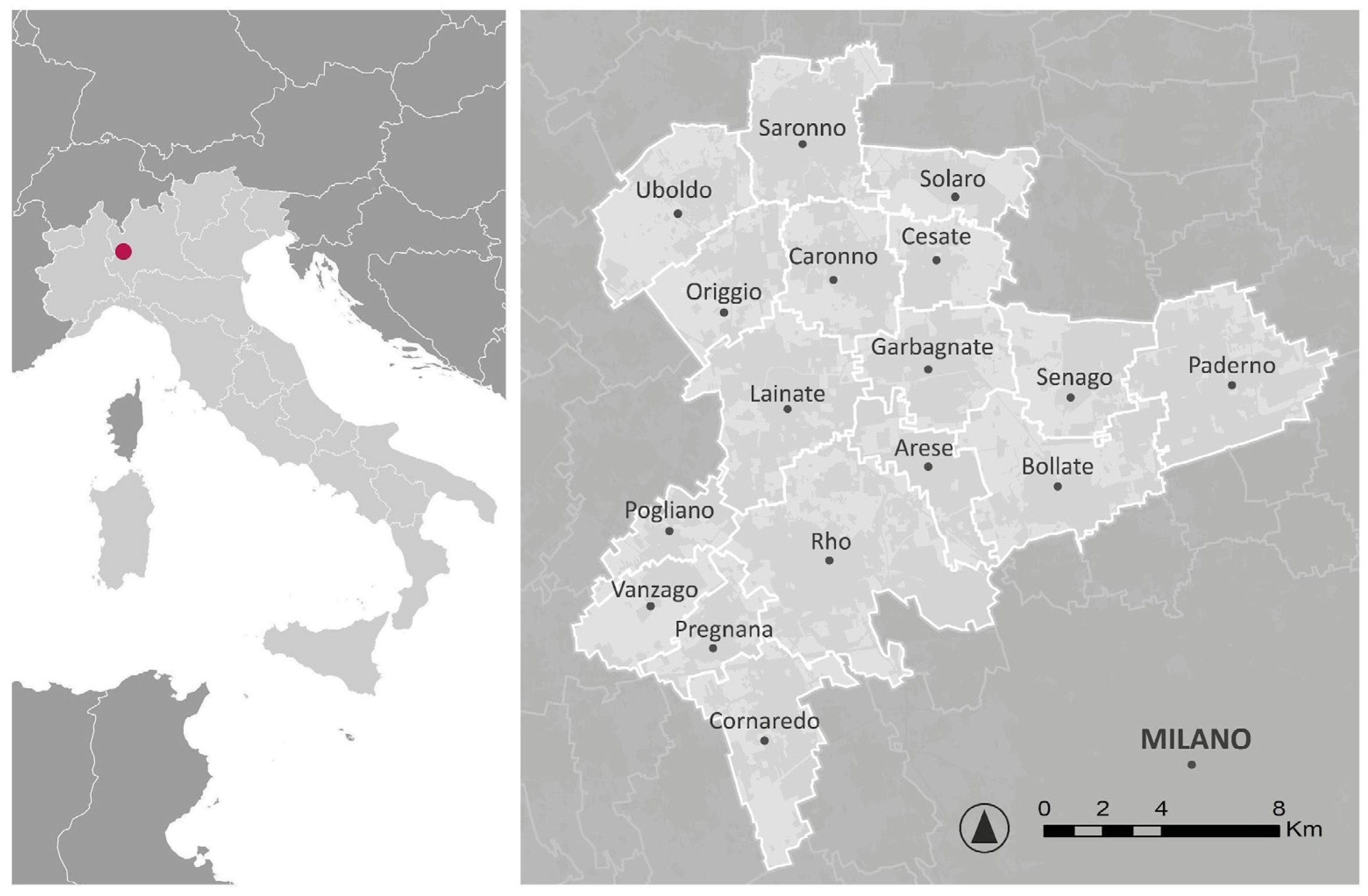
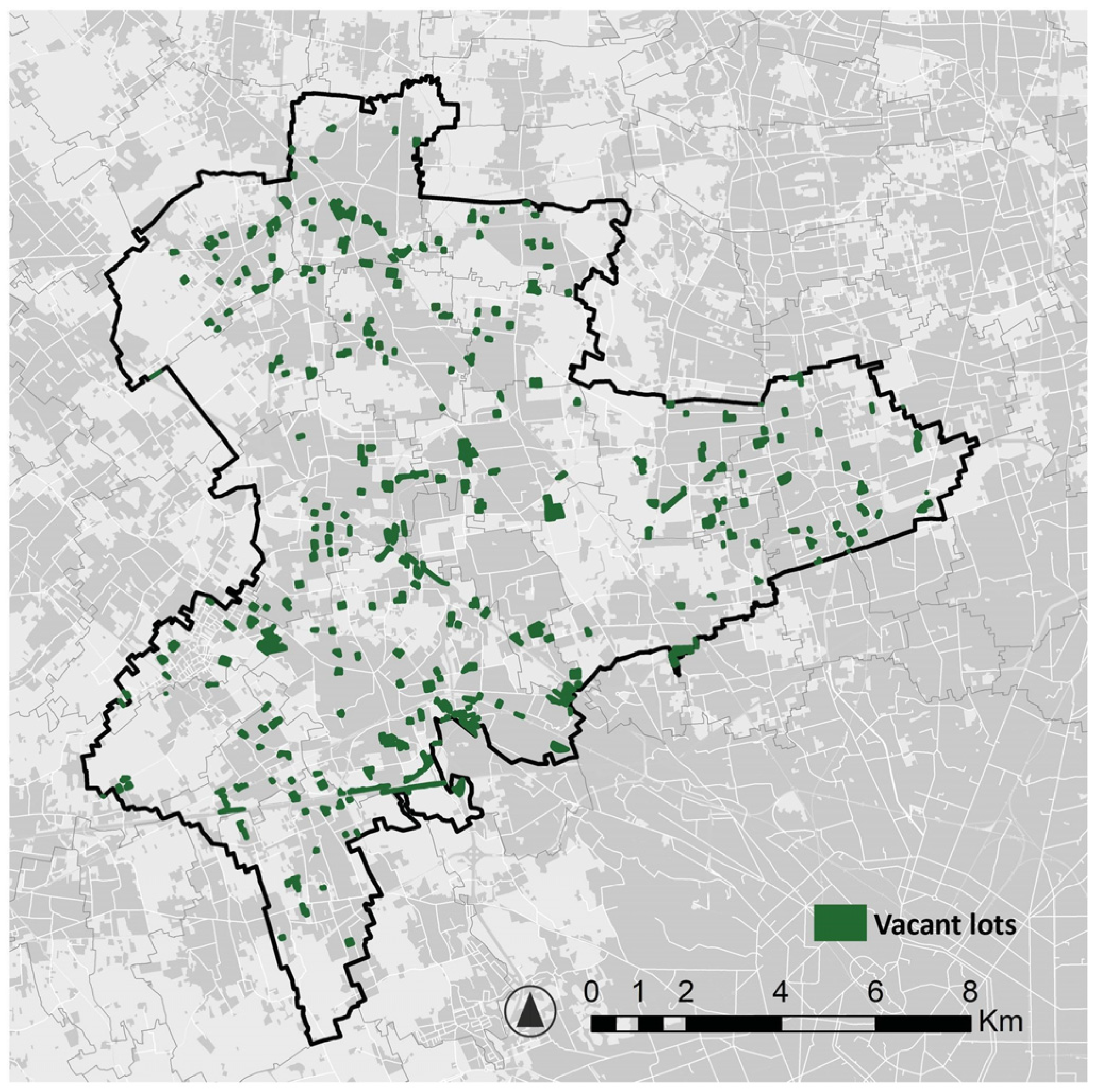
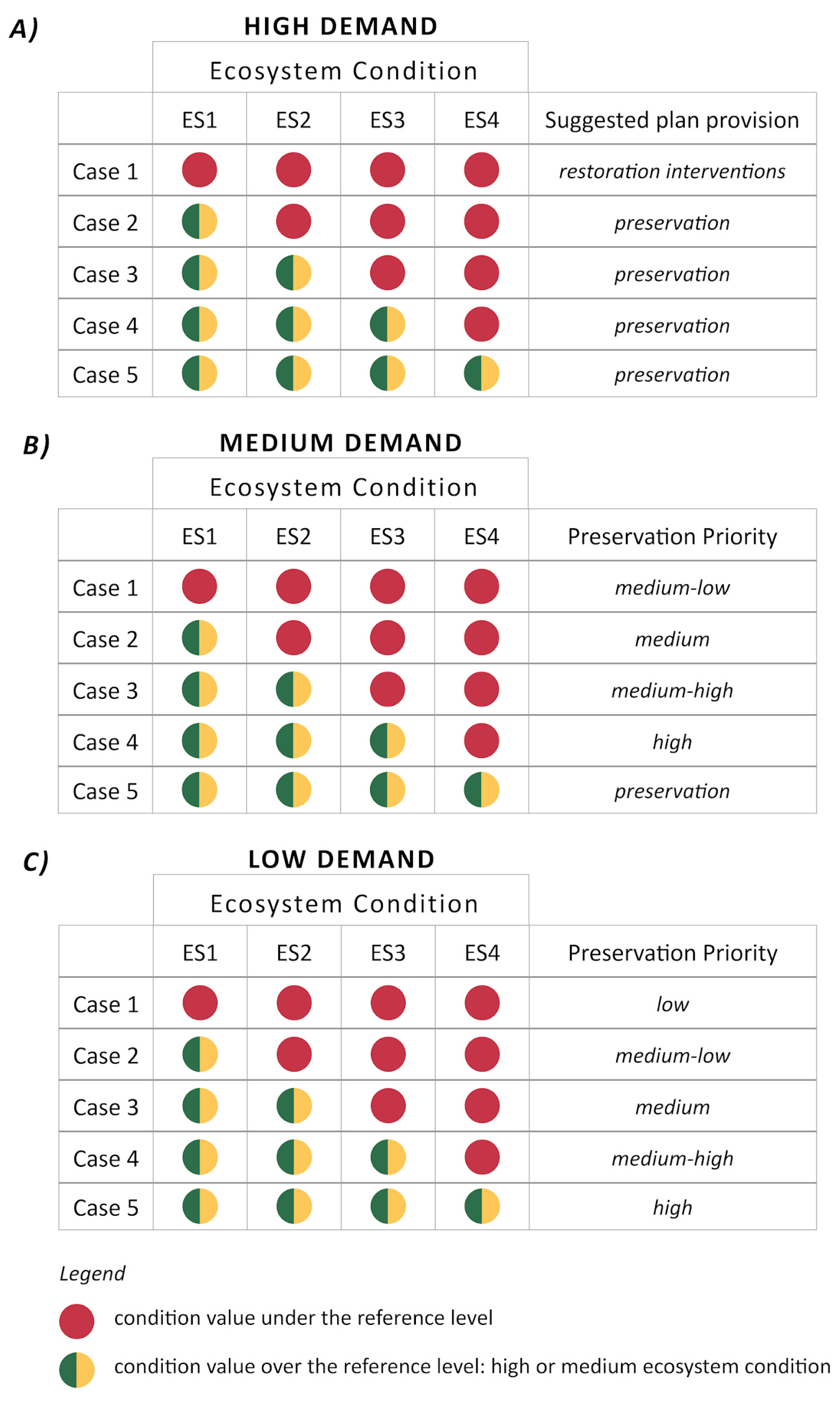

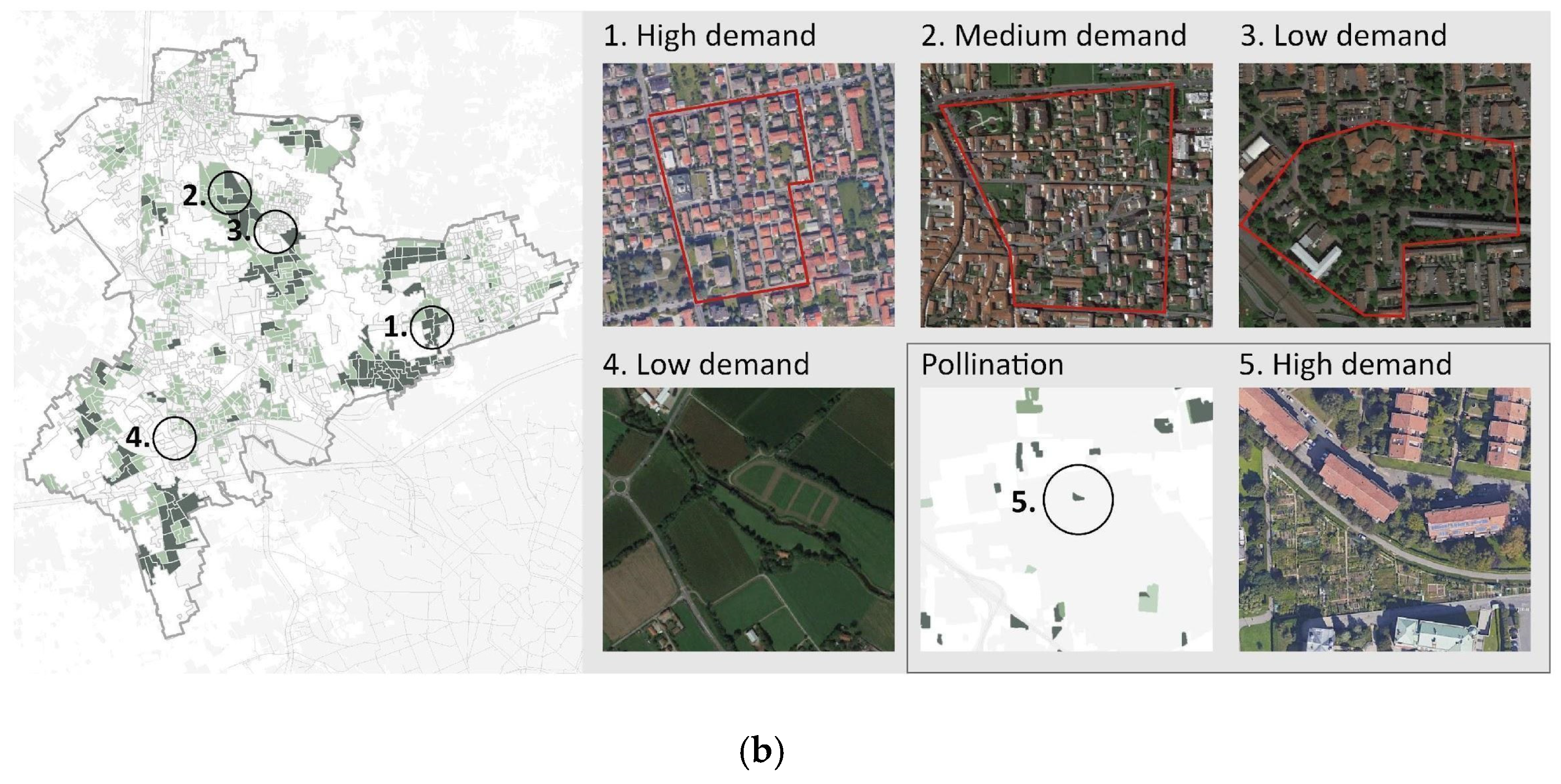
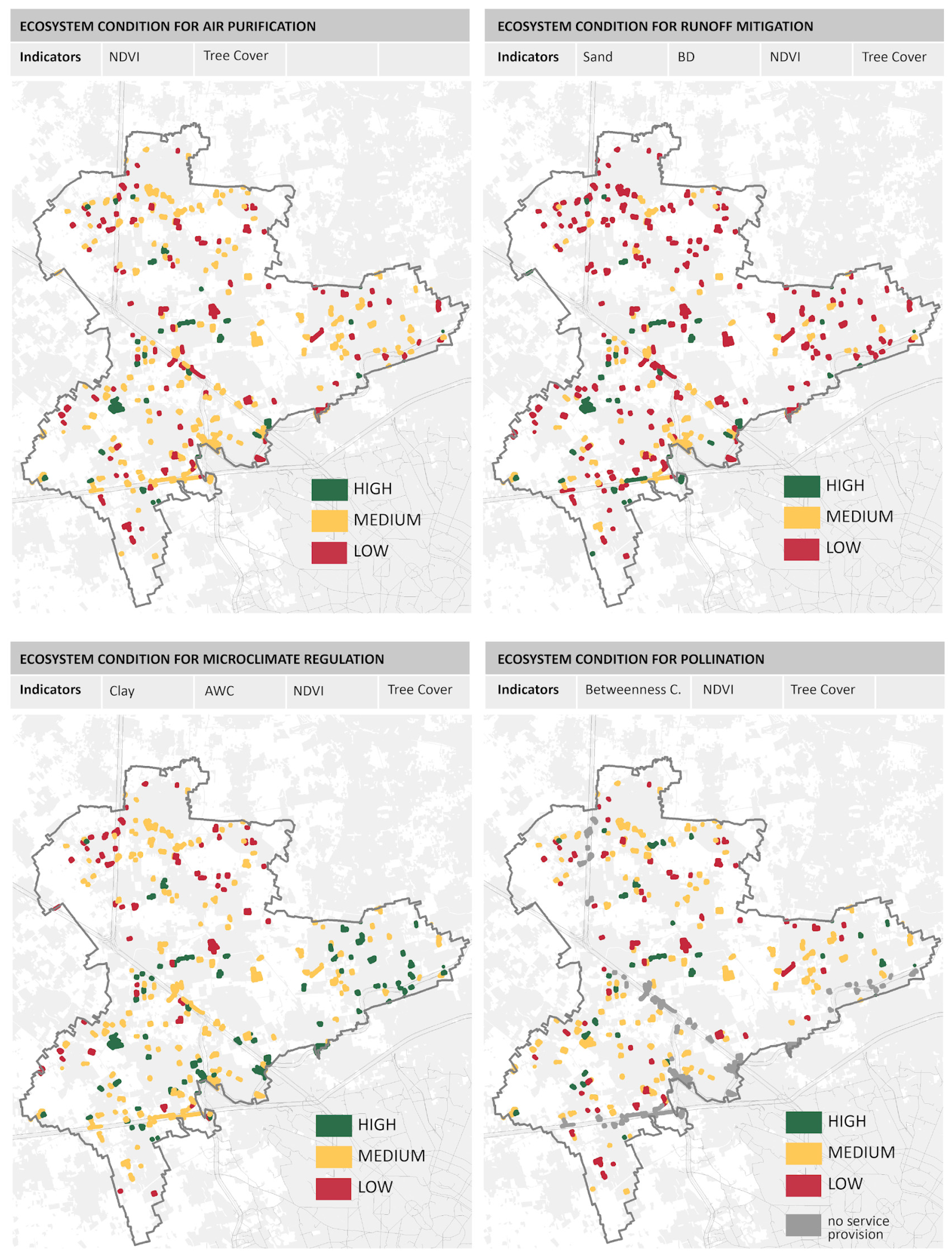
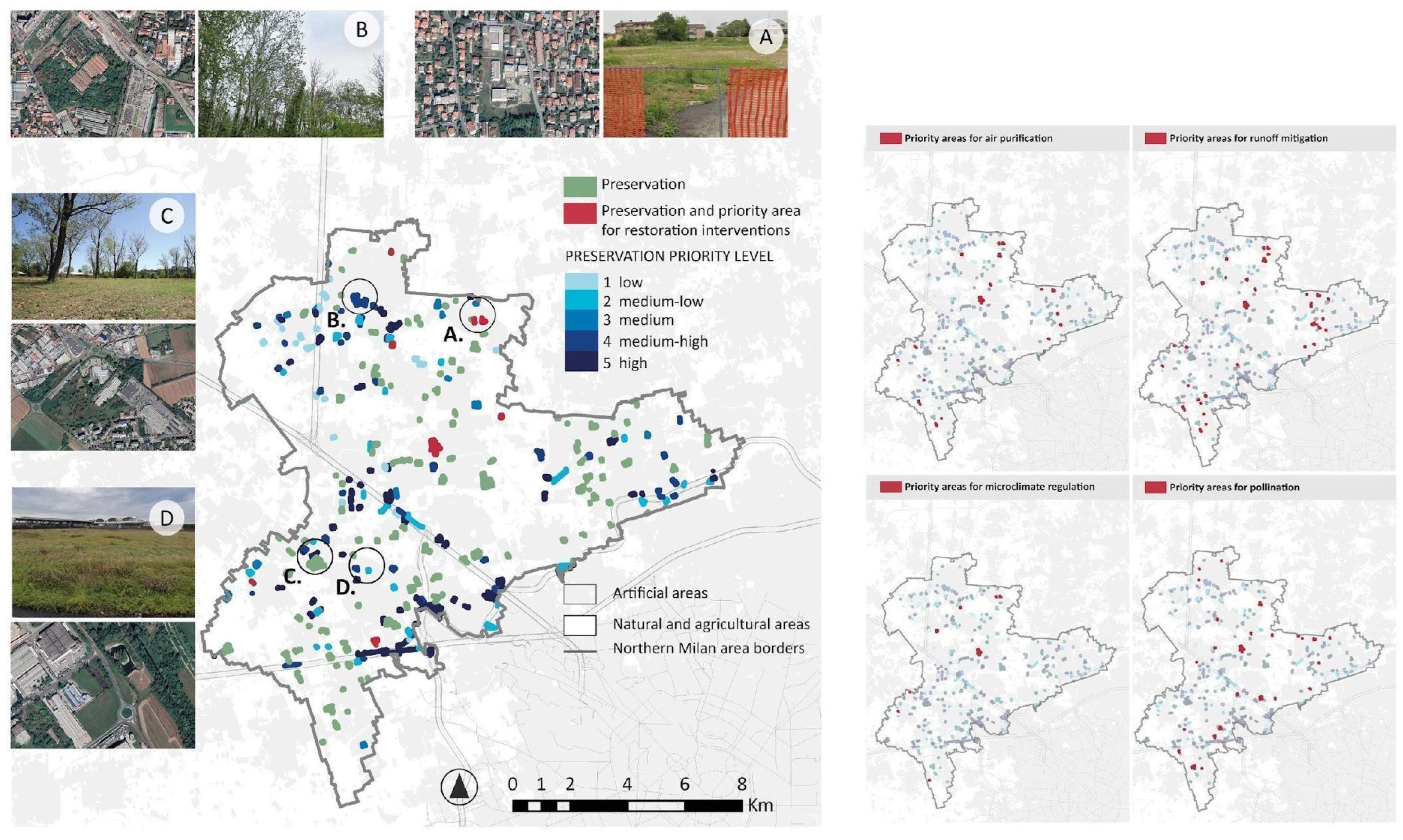
| Ecosystem Service | Hazard Indicator | Exposure Indicator | Method |
|---|---|---|---|
| Air purification | PM10 emission (μg/m3) + Resuspension (%) | Total population | Spatial modelling based on Salata et al. [63] |
| Runoff mitigation | Impermeable surfaces (%) | Total population | Proxy based on impermeable surface (IMD High Resolution Layer Copernicus) |
| Microclimate regulation | Surface temperature (°C) | Total population + vulnerable classes (children and elderlies) | Proxy based on surface temperature (Landsat Collection 2 Surface Temperature) |
| Ecosystem Service | Indicator | Reference | |
| Pollination | Level of pollination dependence by crop type | Ecological modelling based on Fernandes et al. [64] | |
| Nomenclature | Pollination Dependence Level |
|---|---|
| Arable land | No |
| Wooded arable land | Low |
| Vegetable outdoor crops | Medium |
| Vegetable protected crops | No |
| Horticultural outdoor crops | High |
| Horticultural protected crops | No |
| Vegetable gardens | High |
| Vineyards | Low |
| Orchards | High |
| Poplar groves | Low |
| Other orchards | Low |
| Meadows without tree and shrub species | No |
| Meadows with tree and shrub species | Low |
| GROUPS | Typology Class | Indicator | Data Source | Year | Spatial Resolution | Reference Level | |
|---|---|---|---|---|---|---|---|
| Descriptor | Unit | ||||||
| A. ABIOTIC | A1. Physical state characteristics | Clay content | % | ESDAC | 2018 | 500 × 500 m | 20 |
| Sand content | % | ESDAC | 2018 | 500 × 500 m | 25 | ||
| Bulk density | g/cm3 | ESCAD | 2018 | 500 × 500 m | 1.39 | ||
| Available water capacity | % | ESDAC | 2018 | 500 × 500 m | 0.10 | ||
| B. BIOTIC | B2. Structural state characteristics | Maximum annual NDVI | % | Sentinel | 2018 | 10 × 10 m | 0.50 |
| Tree cover density | % | Copernicus | 2018 | 10 × 10 m | 5 | ||
| C. LANDSCAPE | C1. Landscape characteristics | Betweenness centrality | % | DUSAF | 2018 | >0 | |
| Ecosystem Condition Indicators | |||||||
|---|---|---|---|---|---|---|---|
| ABIOTIC | BIOTIC | LANDSCAPE | |||||
| ECOSYSTEM SERVICES | Clay | Sand | Bulk Density | AWC | NDVI | Tree Cover Density | Betweenness Centrality |
| Runoff mitigation | X | X | X | X | |||
| Microclimate regulation | X | X | X | X | |||
| Pollination | X | X | X | ||||
| Air purification | X | X | |||||
Disclaimer/Publisher’s Note: The statements, opinions and data contained in all publications are solely those of the individual author(s) and contributor(s) and not of MDPI and/or the editor(s). MDPI and/or the editor(s) disclaim responsibility for any injury to people or property resulting from any ideas, methods, instructions or products referred to in the content. |
© 2025 by the authors. Licensee MDPI, Basel, Switzerland. This article is an open access article distributed under the terms and conditions of the Creative Commons Attribution (CC BY) license (https://creativecommons.org/licenses/by/4.0/).
Share and Cite
Bruno, E.; Falco, E.; Geneletti, D. Combining Demand for Ecosystem Services with Ecosystem Conditions of Vacant Lots to Support Land Preservation and Restoration Decisions. Sustainability 2025, 17, 4686. https://doi.org/10.3390/su17104686
Bruno E, Falco E, Geneletti D. Combining Demand for Ecosystem Services with Ecosystem Conditions of Vacant Lots to Support Land Preservation and Restoration Decisions. Sustainability. 2025; 17(10):4686. https://doi.org/10.3390/su17104686
Chicago/Turabian StyleBruno, Erica, Enzo Falco, and Davide Geneletti. 2025. "Combining Demand for Ecosystem Services with Ecosystem Conditions of Vacant Lots to Support Land Preservation and Restoration Decisions" Sustainability 17, no. 10: 4686. https://doi.org/10.3390/su17104686
APA StyleBruno, E., Falco, E., & Geneletti, D. (2025). Combining Demand for Ecosystem Services with Ecosystem Conditions of Vacant Lots to Support Land Preservation and Restoration Decisions. Sustainability, 17(10), 4686. https://doi.org/10.3390/su17104686







